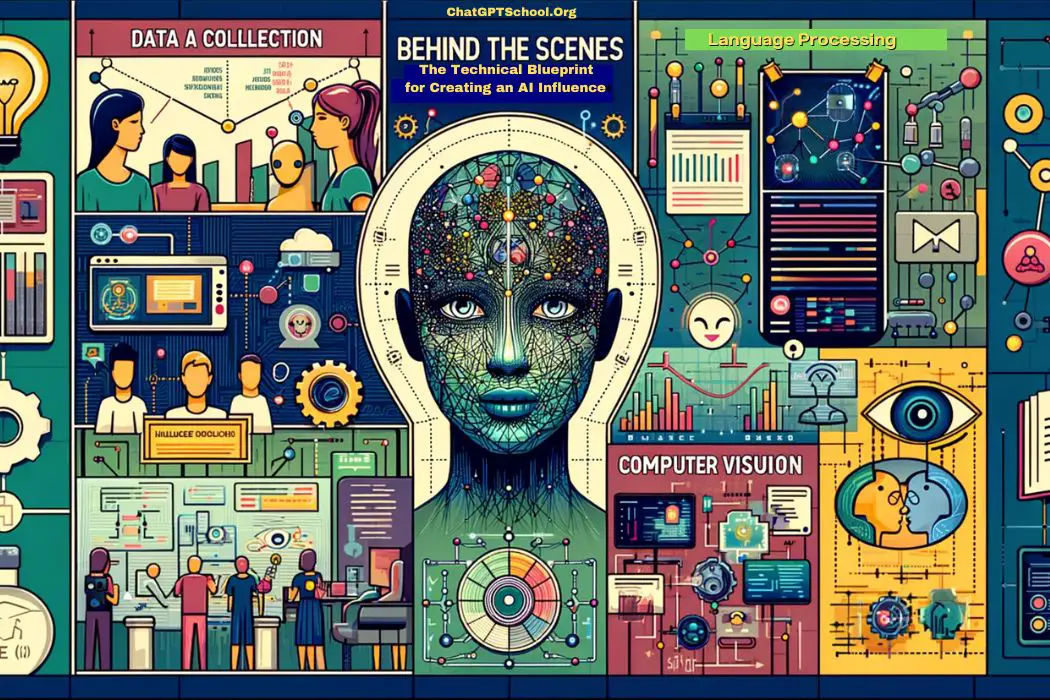
In the landscape of social media and digital marketing, a new player has emerged – the AI influencer.
These digital personas, created using advanced artificial intelligence (AI) technologies, are taking the online world by storm.
But how exactly are these AI influencers created?
What goes on behind the scenes to bring them to life?
In this blog post, we will delve into the technical blueprint for creating an AI influencer, providing you with a comprehensive understanding of the fascinating world of AI-driven digital personalities.
What is an AI Influencer?
Before we dive into the technical aspects, let’s define what an AI influencer is. An AI influencer is a virtual character or persona, often with a strikingly lifelike appearance, voice, and personality, created entirely through the use of artificial intelligence.
These digital influencers can be used for a variety of purposes, from endorsing products and services to providing entertainment and engagement on social media platforms.
AI influencers are distinct from human influencers in that they are entirely computer-generated and lack physical presence. Yet, they can engage with audiences on a deep emotional level, making them a powerful tool for brands and content creators in the digital space.
The Technical Blueprint: How AI Influencers are Created
Creating an AI influencer is a complex process that involves several key components and technologies.
Here’s a step-by-step breakdown of the technical blueprint for bringing these digital personas to life:
1. Data Collection and Analysis
Data collection and analysis is a big first step in the process of creating an AI influencer. This step involves gathering a wide range of data from various sources to serve as the foundation for the digital persona.
Let’s get deeper into this process:
Data Sources:
To create a convincing AI influencer, developers and creators need access to a diverse set of data sources.
These sources can include:
- Social Media Profiles: Scraping information from real social media profiles can provide valuable insights into the influencer’s persona, such as their interests, hobbies, and even the way they communicate with others online.
- Interviews and Public Appearances: If the influencer is modeled after a real person, interviews, speeches, and public appearances can be a rich source of data. Transcripts and videos of these interactions can be analyzed for speech patterns, personality traits, and opinions.
- Fictional Content: In cases where the AI influencer is entirely fictional, writers and developers may create a backstory and personality traits for the character. This fictional content serves as a blueprint for the influencer’s persona.
- Text Data: Text data, including books, articles, and online posts, can be used to analyze the influencer’s language style, vocabulary, and writing patterns. This helps in generating text responses that are consistent with the influencer’s character.
- Images and Videos: Visual data, such as photographs and videos, are essential for creating the influencer’s visual appearance. These images are analyzed to determine facial features, expressions, and body language.
Data Preprocessing:
Once the data is collected from various sources, it needs to be preprocessed. Data preprocessing involves cleaning and organizing the data to make it suitable for analysis.
This includes tasks such as:
- Text Data Cleaning: Removing irrelevant characters, punctuation, and formatting from text data. Tokenization may also be applied to split text into individual words or phrases.
- Image and Video Analysis: Analyzing visual data using computer vision techniques to extract relevant information, such as facial landmarks, emotions, and attributes.
- Audio Transcription: If audio data is available, it can be transcribed into text using speech-to-text technology. This text can then be analyzed alongside other textual data.
Natural Language Processing (NLP):
Once the data is preprocessed, natural language processing (NLP) techniques are employed to extract meaningful insights from the text data. NLP involves a range of tasks, including:
- Sentiment Analysis: Determining the sentiment (positive, negative, neutral) expressed in text. This helps in understanding the influencer’s emotional tone.
- Entity Recognition: Identifying named entities (e.g., people, places, products) mentioned in the text. This can help in building the influencer’s knowledge base.
- Topic Modeling: Analyzing the content to identify recurring topics or themes associated with the influencer’s interests and expertise.
- Language Modeling: Creating language models that capture the influencer’s writing style, vocabulary, and conversational patterns. These models are crucial for generating text responses in the influencer’s voice.
Personality Analysis:
Personality analysis is a critical aspect of data analysis for AI influencers. This involves identifying personality traits and characteristics based on the collected data. Personality insights can be derived from text data, interview transcripts, and other sources. Psychometric assessments and tools may also be used to classify personality traits, helping to shape the influencer’s behaviour and communication style.
Data Labeling:
In some cases, human annotators may be employed to label and annotate the data. This can involve categorizing text data, identifying emotions in videos, or even providing context for specific interactions or events. Data labeling helps train machine learning models and ensures that the AI influencer’s responses are contextually appropriate.
Privacy and Ethical Considerations:
When collecting and analyzing data for AI influencers, it’s crucial to adhere to privacy and ethical guidelines. Ensure that the data is obtained legally and that sensitive information is handled with care.
In addition, transparency about the use of data and the creation of AI influencers is essential to maintain trust with the audience.
Data collection and analysis provide the foundation for creating an AI influencer’s persona. By gathering and analyzing data from various sources, applying NLP techniques, and assessing personality traits, developers can craft a digital personality that closely mimics human behaviour and communication patterns. This robust dataset forms the basis for the subsequent steps in creating a convincing AI influencer, including visual design, speech synthesis, and personality modelling.
2. Natural Language Processing (NLP)
Natural Language Processing (NLP) is a fundamental component in the creation of AI influencers. It plays a crucial role in understanding, generating, and mimicking human language and communication.
Here, we’ll elaborate on the various aspects of NLP in the context of AI influencer development:
Sentiment Analysis:
Sentiment analysis, also known as opinion mining, is a key NLP task used to determine the emotional tone expressed in text. For AI influencers, sentiment analysis helps in understanding and mirroring emotions in their interactions with the audience.
Here’s how sentiment analysis works:
- Positive, Negative, Neutral: Sentiment analysis categorizes text into three main sentiments: positive, negative, and neutral. This information helps AI influencers respond with appropriate emotions to user comments or engage in conversations that align with their persona.
- Emotion Detection: More advanced sentiment analysis models can detect specific emotions, such as happiness, sadness, anger, or excitement, expressed in text. This capability allows AI influencers to respond with emotionally relevant content.
Entity Recognition:
Entity recognition, also known as named entity recognition (NER), is an NLP technique used to identify and classify named entities in text. Named entities can include names of people, places, organizations, products, and more.
In the context of AI influencers:
- Building Knowledge: Entity recognition helps in building the influencer’s knowledge base by identifying and categorizing relevant entities. This knowledge is crucial for providing informed responses and engaging in discussions about specific topics.
- Personalization: AI influencers can use entity recognition to personalize their interactions. For example, they can address users by their names, reference specific locations or products, and provide contextually relevant information.
Topic Modeling:
Topic modelling is a technique used to identify recurring topics or themes in a collection of documents, such as text data.
It helps AI influencers stay informed about popular trends and discussions within their niche:
- Content Generation: AI influencers can use topic modeling to generate content ideas that are relevant to current trends and discussions. This ensures that their interactions and posts remain up-to-date and engaging.
- Engagement Strategy: Understanding prevalent topics allows AI influencers to engage in conversations that resonate with their audience. They can participate in discussions, share opinions, and provide valuable insights on trending subjects.
Language Modelling:
Language modelling involves creating a statistical model of language patterns and structures. For AI influencers, language modelling is essential for capturing and replicating the influencer’s unique writing style, vocabulary, and conversational patterns:
- Writing Style: Language models learn the influencer’s writing style, including sentence structure, word choices, and tone. This enables them to generate text that closely matches the influencer’s voice.
- Conversational Responses: AI influencers can use language models to generate natural and contextually appropriate responses to user comments and questions. The responses are designed to mimic the influencer’s typical conversational style.
Language Generation:
Language generation is a broader NLP task that involves generating coherent and contextually relevant text. AI influencers rely on language generation to craft their responses and create engaging content:
- Content Creation: AI influencers can generate blog posts, social media updates, and other types of content that align with their persona. This content can be informative, entertaining, or promotional, depending on the influencer’s purpose.
- Personalized Interactions: Language generation allows AI influencers to engage in personalized interactions with users. They can answer questions, provide recommendations, and maintain conversations that feel natural and human-like.
Contextual Understanding:
NLP models are trained to understand context in language. This is essential for AI influencers as it enables them to provide relevant responses that consider the ongoing conversation:
- Contextual Responses: AI influencers can take into account the context of previous messages or comments when generating responses. This makes interactions feel more fluid and coherent.
- Understanding User Intent: NLP models can analyze user queries and intents to provide responses that address the user’s needs effectively. This is particularly valuable for AI influencers in customer support or advisory roles.
Natural Language Processing is a vital component of creating AI influencers. It empowers these digital personas to understand, interpret, and generate human language effectively, allowing them to engage with their audience in a meaningful and relatable manner.
Through sentiment analysis, entity recognition, topic modelling, language modelling, language generation, and contextual understanding, AI influencers can provide personalized, emotionally resonant, and contextually relevant interactions, enhancing their authenticity and engagement with users.
3. Computer Vision
Computer vision is a crucial component in the creation of AI influencers, especially when it comes to crafting their visual appearance and enhancing their ability to engage with users through images and videos.
Here, we’ll delve into the role of computer vision in AI influencer development:
Face Detection and Recognition:
- Face Detection: Computer vision algorithms are used to detect and locate human faces within images and videos. This is essential for AI influencers, as their virtual personas often have lifelike facial features.
- Facial Landmark Detection: Once faces are detected, computer vision can identify key facial landmarks, such as eyes, nose, and mouth. This allows AI influencers to exhibit a range of facial expressions and emotions, making their interactions more engaging and relatable.
- Facial Recognition: In some cases, facial recognition technology may be employed to ensure consistency in the influencer’s appearance across different media. This technology helps maintain the influencer’s identity, even in various lighting conditions or angles.
Emotion Analysis:
- Emotion Detection: Computer vision models can analyze facial expressions to detect emotions such as happiness, sadness, anger, and surprise. This capability enables AI influencers to respond to users’ emotional cues appropriately.
- Emotional Engagement: By recognizing emotions in user-generated content (e.g., images of users’ faces), AI influencers can tailor their responses to match the emotional tone of the interaction. This enhances the influencer’s ability to engage with users on a deeper emotional level.
Image and Video Analysis:
- Object Detection: Computer vision algorithms can identify and categorize objects and elements within images and videos. This allows AI influencers to understand the visual context and respond accordingly.
- Scene Analysis: Understanding the scene or environment depicted in images or videos is crucial for providing contextually relevant responses. For example, if the influencer sees an image of a beach, they can comment on it in a manner consistent with their persona.
Body Language and Gestures:
- Body Language Analysis: In addition to facial expressions, computer vision can also analyze body language and gestures in videos. This provides AI influencers with the ability to convey non-verbal cues and engage in more expressive interactions.
- Gesture Recognition: Some AI influencers may incorporate gesture recognition technology to interpret user gestures and respond with appropriate actions or gestures of their own, enhancing the interactive experience.
Visual Content Creation:
- Image and Video Generation: Computer vision, in conjunction with generative adversarial networks (GANs), can be used to create images and videos of the AI influencer in various scenarios and poses. This is particularly useful for generating promotional content and visual posts on social media.
- Visual Effects: Computer vision can also be used to apply visual effects, filters, and animations to the influencer’s image or video content, adding a layer of creativity and engagement to their posts.
Visual Identity Maintenance:
- Consistency in Appearance: Computer vision can help ensure that the AI influencer’s appearance remains consistent across different media and platforms. This includes maintaining the influencer’s facial features, hairstyle, and clothing style.
- Adaptation to Scenarios: Computer vision can adapt the influencer’s appearance to suit different scenarios and themes. For example, if the influencer is discussing travel, their virtual background and attire can be adjusted to match a travel-related theme.
Content Moderation:
- Content Filtering: Computer vision models can be employed to moderate user-generated content and filter out inappropriate or offensive images and videos. This helps maintain a positive and safe environment around the AI influencer.
Computer vision is a critical technology in the creation of AI influencers. It empowers these digital personas with the ability to perceive and understand visual content, recognize emotions, exhibit facial expressions, and engage with users through images and videos.
By incorporating computer vision capabilities, AI influencers can offer more immersive and visually appealing interactions, making them even more captivating and relatable to their audience.
4. Speech Synthesis
To give the AI influencer a voice, speech synthesis technology is employed. Text-to-speech (TTS) algorithms can convert written text into lifelike spoken language. These algorithms have come a long way, producing voices that are indistinguishable from those of real humans.
This lets AI influencers communicate with their audiences through spoken words, enhancing their overall authenticity.
5. Generative Adversarial Networks (GANs)
One of the most revolutionary technologies used in creating AI influencers is generative adversarial networks (GANs). GANs consist of two neural networks, a generator and a discriminator, that work in opposition to each other. The generator creates content (such as images or videos of the influencer), while the discriminator evaluates its quality.
Through a process of competition and improvement, GANs can produce highly realistic and convincing visuals of the AI influencer.
6. Personality Modeling
Developing the personality of the AI influencer is a crucial step in the process. Personality modeling combines the insights gained from data analysis with the ability to generate contextually appropriate responses using NLP. By modelling the influencer’s personality, AI can mimic human-like interactions and engage with users in a way that feels genuine and relatable.
7. Integration with Social Media Platforms
Once the AI influencer is created, it needs to be integrated into social media platforms and other digital channels. This involves creating accounts, managing content, and scheduling posts, just like a human influencer would. The AI influencer can interact with users, respond to comments, and even participate in live streams, making them virtually indistinguishable from their human counterparts.
8. Continuous Learning and Improvement
Creating an AI influencer is an ongoing process. The influencer’s algorithms are continuously trained and improved based on user interactions and feedback. Machine learning models analyze the influencer’s performance and adjust its behaviour, responses, and appearance to better meet the expectations and preferences of its audience.
Challenges and Ethical Considerations
While the creation of AI influencers is a remarkable technological achievement, it also raises several challenges and ethical considerations.
Here are some of the key issues:
1. Transparency
One of the major concerns is transparency. Audiences may not always be aware that they are interacting with AI-driven influencers rather than real humans. It is essential for creators and brands to be transparent about the nature of these digital personas to maintain trust with their audience.
2. Manipulation
AI influencers can be programmed to promote products and ideas, potentially leading to manipulation of public opinion. Striking the right balance between marketing and responsible content creation is crucial to avoid unethical practices.
3. Identity Theft
The data used to create AI influencers often comes from various sources, raising concerns about data privacy and identity theft. Ensuring that data is obtained and used ethically and legally is of utmost importance.
4. Regulation
As AI influencers become more prevalent, there is a growing need for regulation and guidelines to govern their creation and use. Governments and industry bodies are beginning to explore frameworks to address these emerging issues.
Conclusion
Creating an AI influencer is a technical marvel that combines natural language processing, computer vision, speech synthesis, GANs, and personality modelling. These digital personas are redefining the landscape of influencer marketing and entertainment on social media platforms.
However, with great power comes great responsibility, and ethical considerations surrounding transparency, manipulation, identity theft, and regulation must be carefully addressed.
As the technology behind AI influencers continues to advance, it is crucial for creators, brands, and the industry as a whole to prioritize ethical practices and transparency in order to build and maintain trust with their audiences.
The future of AI influencers is undoubtedly exciting, but it is essential that we navigate this new frontier with a keen awareness of the potential implications and consequences.
The technical blueprint we’ve explored in this blog post is just the beginning of a fascinating journey into the world of AI-driven digital personalities.
As technology evolves and our understanding deepens, we can expect even more realistic and engaging AI influencers to captivate and interact with audiences across the digital landscape.





